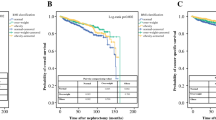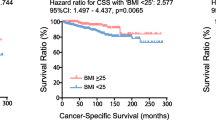Abstract
Objective
The aim of the current study was to examine the impact of preoperative body mass index (BMI) in Korean patients with surgically treated renal cell carcinoma (RCC).
Methods
From 1994 to 2008, a total of 1,487 patients underwent nephrectomy for RCC. All patients were classified into three groups according to Asian BMI classification by Asia Cohort Consortium: <18.5, 18.5 to <25, and 25 kg/m2 or greater group, which represents the underweight (n = 42, 2.8%), normal (n = 833, 56.0%), and obesity (n = 612, 41.2%) group, respectively. Survival analyses and predictive factors for cancer-specific survival among the three groups were evaluated. Subgroup survival analysis of organ-confined and advanced disease was performed.
Results
An overall median follow-up was 54.8 months. Mean ± SE estimated cancer-specific survival in all patients at 5 and 10 years was 88.0 ± 1.0% and 81.4 ± 1.4%, respectively. In the multivariate model after adjusting preoperative and postoperative variables, the underweight group had a significantly worse prognosis than the normal group (hazard ratio (HR): 2.17, 95% confidence interval (95% CI): 1.16–4.08, p = 0.016), meanwhile the obesity group was associated with improved survival (HR: 0.66, 95% CI: 0.45–0.96, p = 0.032). In the subgroup analysis of advanced RCC, obesity was associated with better prognosis than the normal group after applying multivariate analysis (p = 0.001).
Conclusions
Preoperative underweight could be a new independent factor to predict unfavorable cancer-specific survival in Korean patients with RCC treated by surgery. Moreover, obesity was verified to be associated with superior cancer-specific survival.



Similar content being viewed by others
References
Ljungberg B, Campbell SC, Cho HY et al (2011) The epidemiology of renal cell carcinoma. Eur Urol 60:615–621
Adams KF, Leitzmann MF, Albanes D et al (2008) Body size and renal cell cancer incidence in a large US cohort study. Am J Epidemiol 168:268–277
Samanic C, Chow WH, Gridley G, Jarvholm B, Fraumeni JJ (2006) Relation of body mass index to cancer risk in 362,552 Swedish men. Cancer Causes Control 17:901–909
McGuire BB, Fitzpatrick JM (2011) BMI and the risk of renal cell carcinoma. Curr Opin Urol 21:356–361
Pischon T, Lahmann PH, Boeing H et al (2006) Body size and risk of renal cell carcinoma in the European prospective investigation into cancer and nutrition (EPIC). Int J Cancer 118:728–738
Chow WH, Dong LM, Devesa SS (2010) Epidemiology and risk factors for kidney cancer. Nat Rev Urol 7:245–257
Parker AS, Lohse CM, Cheville JC, Thiel DD, Leibovich BC, Blute ML (2006) Greater body mass index is associated with better pathologic features and improved outcome among patients treated surgically for clear cell renal cell carcinoma. Urology 68:741–746
Calle EE, Rodriguez C, Walker-Thurmond K, Thun MJ (2003) Overweight, obesity, and mortality from cancer in a prospectively studied cohort of U.S. adults. N Engl J Med 348:1625–1638
Donat SM, Salzhauer EW, Mitra N, Yanke BV, Snyder ME, Russo P (2006) Impact of body mass index on survival of patients with surgically treated renal cell carcinoma. J Urol 175:46–52
Waalkes S, Merseburger AS, Kramer MW et al (2010) Obesity is associated with improved survival in patients with organ-confined clear-cell kidney cancer. Cancer Causes Control 21:1905–1910
Haferkamp A, Pritsch M, Bedke J et al (2008) The influence of body mass index on the long-term survival of patients with renal cell carcinoma after tumour nephrectomy. BJU Int 101:1243–1246
WHO Expert Consultation (2004) Appropriate body-mass index for Asian populations and its implications for policy and intervention strategies. Lancet 363:157–163
Zheng W, McLerran DF, Rolland B et al (2011) Association between body-mass index and risk of death in more than 1 million Asians. N Engl J Med 364:719–729
The Korean Society For the Study of Obesity (2009) Guideline of Obesity in Korean. http://kosso.or.kr. Accessed 5 September 2011
Edge SB, Byrd DR, Compton CC, Fritz AG, Greene FL, Trotti A (2009) American joint committee on cancer (AJCC) staging manual, 7th edn. Springer, Philadelphia
Fuhrman SA, Lasky LC, Limas C (1982) Prognostic significance of morphologic parameters in renal cell carcinoma. Am J Surg Pathol 6:655–663
Rasmuson T, Grankvist K, Jacobsen J et al (2004) Sereum insulin-like growth factor-1 is an independent predictor of prognosis in patients with renal cell carcinoma. Acta Oncol 43:744–748
Mullen JT, Davenport DL, Hutter MM et al (2008) Impact of body mass index on perioperative outcomes in patients undergoing major intra-abdominal cancer surgery. Ann Surg Oncol 15:2164–2172
Morgan TM, Tang D, Stratton KL et al (2011) Preoperative nutritional status is an important predictor of survival in patients undergoing surgery for renal cell carcinoma. Eur Urol 59:923–928
Ogden CL, Carroll MD, Curtin LR, McDowell MA, Tabak CJ, Flegal KM (2006) Prevalence of overweight and obesity in the United States, 1999–2004. JAMA 295:1549–1555
Ogden CL, Yanovski SZ, Carroll MD, Flegal KM (2007) The epidemiology of obesity. Gastroenterology 132:2087–2102
Flegal KM, Graubard BI, Williamson DF, Gail MH (2005) Excess deaths associated with underweight, overweight, and obesity. JAMA 293:1861–1867
Kim HL, Belldegrun AS, Freitas DG et al (2003) Paraneoplastic signs and symptoms of renal cell carcinoma: implications for prognosis. J Urol 170:1742–1746
Kim HL, Han KR, Zisman A, Figlin RA, Belldegrun AS (2004) Cachexia-like symptoms predict a worse prognosis in localized t1 renal cell carcinoma. J Urol 171:1810–1813
Morley JE, Thomas DR, Wilson MM (2006) Cachexia: pathophysiology and clinical relevance. Am J Clin Nutr 83:735–743
Conflict of interest
There is no conflict of interests.
Author information
Authors and Affiliations
Corresponding author
Rights and permissions
About this article
Cite this article
Sung, H.H., Jeon, S.S., Park, S.Y. et al. Impact of body mass index in Korean patients with renal cell carcinoma. Cancer Causes Control 23, 505–511 (2012). https://doi.org/10.1007/s10552-012-9910-4
Received:
Accepted:
Published:
Issue Date:
DOI: https://doi.org/10.1007/s10552-012-9910-4




